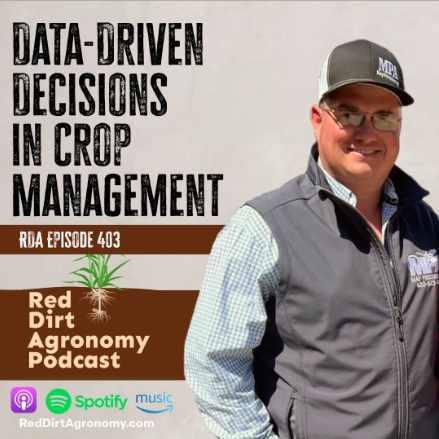
In this episode of the Red Dirt Agronomy Podcast, Jerry May of May Precision Ag (MPA) in Kiowa, Kansas, discusses the evolution of precision agriculture. May shares his journey from working with John Deere to establishing a successful custom farming business and also discusses how market dynamics, such as cattle prices and wheat production, influence farmers’ decisions.
Fresh out of grad school at OSU, May worked for John Deere in Amarillo, Texas, as an agronomist focused on supporting the new, data-driven technology being produced. From there, he was an agronomist for a local co-op and ran a sprayer for them. He left that position to begin a grid, soil sampling enterprise of his own which he named May Precision Ag.
“We did bulk soil sampling, grid sampling, zone sampling,” he said. “A few years after that, another graduate friend, Cody Daft, asked me if I wanted to start selling seed. I was already giving crop recommendations, so I might as well be able to sell the seed with it. I started selling Pioneer Seed.”
From there, dealing in chemicals and fertilizers was a natural next step. In 2019, he purchased a custom application business. He took up farming on a small scale and realized the high cost of equipment. To offset that expense, he began to hire out as a custom farmer for others.
After years of working with experienced agronomists, May realized that many producers were unaware of advanced scientific methods to boost yields and profits. Motivated by this insight, he has taken the initiative to educate producers on these rapidly evolving practices and technologies.
Custom Spraying and Harvest companies have been commonplace for some time, but Custom Planting was a unique endeavor for May because drills are not too expensive for each farmer to have one of their own.
It is the advancing ages of the U.S. farmer, averaging around 71 years old, that has propelled MPA’s success. “What 71-year-old farmer wants to go out and spend that kind of money on a piece of equipment?” he asked. “If that 71-year-old owns the ground, it is easier to call us, let us plant it, and avoid going into debt again.”
Additionally, May can layer the benefits of the soil sampling and seed and chemical recommendations he makes to the farmers he serves to give them a data-driven, very customized crop management plan. His program ventures beyond crop consulting, nearer to a farm management role.
“There is a lot of data that is going into farming right now,” May said. “You just don’t go buy a semi-load of seed wheat and put it in the ground and then call the co-op in February and just go top-dress your wheat.”
When May was growing up on his parents’ farm in the ‘90s, every field was planted with winter wheat and they all grazed cattle through the winter months. Some grew feed for their cows in other fields, but not many. He said that the biggest change that came to farming in that area was the introduction of winter canola in the early 2000s.
“The wheat following your winter canola has fifteen to twenty percent better yields,” May touted. “A lot of guys started doing that and it brought in more corn and a whole lot more soybean acres, and grain sorghum acres. Everybody started to rotate their crops a little bit. These days, there are a lot of rotational crops.”
The diversity of crops in the area makes having an experienced agronomist paramount for making chemical, rotational, and variety decisions.
While more wheat farmers, now, are choosing between grazing cattle on their wheat or harvesting it for grain rather than relying upon a dual-purpose product, May said that this year, there was more dual-purpose wheat planted than single-purpose due to a timely rain last September that allowed them to put the wheat in early. However, when comparing wheat prices to cattle prices, it is debatable how many will continue to seek a dual purpose for their wheat after the grazing season has passed.
The demand for MPA has also changed with time and technological advancements. When he started, producers only wanted grid soil sampling, now that data collection is simplified, and machinery is so advanced, precision agriculture is becoming a growing trend.
Click here to listen to the entire Red Dirt Agronomy Podcast episode.


















